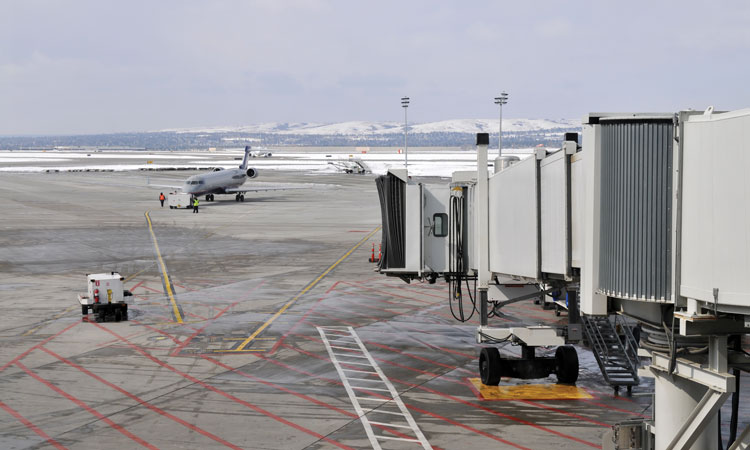Ready for anything – Winter Operations
- Like
- Digg
- Del
- Tumblr
- VKontakte
- Buffer
- Love This
- Odnoklassniki
- Meneame
- Blogger
- Amazon
- Yahoo Mail
- Gmail
- AOL
- Newsvine
- HackerNews
- Evernote
- MySpace
- Mail.ru
- Viadeo
- Line
- Comments
- Yummly
- SMS
- Viber
- Telegram
- Subscribe
- Skype
- Facebook Messenger
- Kakao
- LiveJournal
- Yammer
- Edgar
- Fintel
- Mix
- Instapaper
- Copy Link
Posted: 13 August 2014 | Roy McLeod | No comments yet
With an unpredictable climate that can experience snow during all 12 months of a year, it’s essential that Calgary International Airport has a reliable winter operations plan, explains Director of Airside Facilities, Roy McLeod


Calgary International Airport (YYC) is located a short 80km from the eastern slopes of the Rocky Mountains, which attributes to the diverse weather that Calgary can be exposed to. From dramatic temperature changes to unpredictable precipitation and winds, Calgary can see it all. The city sits at an elevation of 1,084 meters (3,557 feet) above sea level and is reported to see more days of sunshine than any other Canadian City. It can also experience snow in all 12 months of any given year.
Calgary is an economic region that is home to more than 1.4 million people, but the city is proud of the fact that despite its success it has always maintained a small town feel and friendliness. The same can be said for Calgary International Airport. Despite its growth to over 14.3 million passengers annually, making YYC the third busiest airport in Canada, the airport is a business built on being a hub to major air carriers as well as a key driver to the economic success of the city, province and region it serves.
As a result, The Calgary Airport Authority is focused on operational efficiency, which is especially true when it comes to winter operations at YYC. Calgary’s unique weather patterns create a challenge for YYC crews, who prepare for many different weather conditions that can range from summer storms and lightning, to blizzard conditions with extreme wind chill. The airport’s close proximity to the Rocky Mountains can play havoc with the weather. One such condition is a weather system called ‘Chinooks’, which is warm winds caused by moist weather patterns, originating off the Pacific coast, cooling as they climb the western slopes, and then rapidly warming and drying as they drop down the eastern side of the mountains. Chinooks can deliver remarkably warm dry winds, which are also factored into the airport’s Winter Operations Plan.
Due to these weather anomalies, airport operations monitor multiple forecasts and radar maps. Operations plans are designed to allow for flexibility and agility in response to actual conditions. Once a plan to tackle the weather event is decided upon, good communication to all airport stakeholders is essential. The Authority involves all YYC’s airport partners in the decision process in order to maintain an open line of communication with the airlines, corporate operators, Nav Canada, and service providers affected. It’s important for the Authority to ensure that winter operations run as smoothly as possible and that all airport partners’ needs are met to ensure on-time performance.
YYC uses a fleet of six Vammas PSB-5500 and nine ATI Snow Mauler PSV-400’s, coupled with Wausau sweepers to clear the main movement areas. These sweepers run with 27 and 25-foot poly plows, and are supported by John Deere K-744 loaders, with 30 Ramp Hog blades, and Oshkosh H-Series snow blowers, which can handle almost any weather event.
A combination of the equipment, identification of priority areas and collaborative decision making from a Snow Operations Desk results in an efficient and effective Winter Operations Plan. When inclement weather is imminent, teams begin by preparing for the worst-case scenario. The Airfield Supervisor, in conjunction with the Airport Duty Manager and Nav Canada collaborate on an action plan that ensures minimal impact on air traffic capacity. If it is determined the weather may start to impact the flow of air traffic, a call is made to activate the airport’s Snow Desk. YYC’s Snow Desk has representation from major carriers, ground handling service providers, de-icing service providers, corporate air carriers, and YYC’s operations team. It’s a critical component to ensuring that all our partners are in one room making the right decisions at the right time.
YYC often initiates winter maintenance windows to allow for quick and easy clearing of manoeuvring areas. In most cases the operations plans for 15 minute windows, allowing teams to make two passes, with four sweepers, clearing the full length and 150-160ft of the width runway. Other crews are then focused on clearing the critical high speed exits out to the taxiways. Operations also assign sweepers to the main apron in support of the Ramp Hogs and back plow/snow blow as soon as possible or as required.
YYC’s new 14,000ft-long parallel runway was due to open on 28 June 2014, which when coupled with associated taxiways will be bringing on an added 725,000 plus square metres of surface to snow clear. The parallel runway will provide much needed relief to the current constraints faced during snow and ice removal. The addition of the runway will aid in improved flow rates during the winter, despite the added surface and the demands it will place on both equipment and operators.
YYC is focused on keeping things simple and efficient. It’s been a successful model that aligns all the moving parts to offer the most cost effective operation possible. The airport will continue to work with partners and stakeholders to ensure their expectations are met and more often exceeded, with flexible plans and fresh approaches to weather challenges in an ever-changing, fast-paced environment.
Biography
Roy McLeod is Director of Airside Services at the Calgary Airport Authority. He oversees 2,086 hectares of airfield infrastructure including maintenance of all hard and soft surface areas owned and operated by YYC including runways, taxiways, aprons, roads, grass areas, as well as fleet maintenance of YYC owned and leased vehicles. Roy has 28 years of senior management experience in the service industry at multiple North American airports; dealing mostly with operations, heavy equipment repair, and labour relations. He is an active member of the SWIFT Committee and will be looking forward to the fellowship and challenges ahead.


















